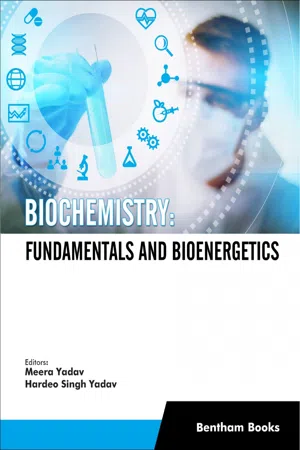
- English
- ePUB (mobile friendly)
- Available on iOS & Android
Biochemistry: Fundamentals and Bioenergetics
About This Book
Biochemistry: Fundamentals and Bioenergetics presents information about the basic andapplied aspects of the chemistry of living organisms. The textbook covers the scopeand importance of biochemistry, the latest physical techniques to determine biomolecularstructure, detailed classification, structure and function of biomolecules suchas carbohydrates, lipids, amino acids, proteins, nucleic acids, vitamins, enzymes and hormones. Readers will also learn aboutprocesses central to energy metabolism including photosynthesis andrespiration, oxidative phosphorylation, DNA replication, transcription andtranslation, recombinant DNA technology. Key Features- logical approach to biochemistry with several examples- 10 organizedchapters on biochemistry fundamentals and metabolism- focus onbiomolecules and biochemical processes - referencesfor further reading Biochemistry: Fundamentals and Bioenergetics is a useful textbook for undergraduatestudents involved in courses in life sciences, biochemistry and other branchesof natural sciences.
Frequently asked questions
Information
Structure and Function of Biological Biomolecules: Carbohydrates, Amino Acids, Proteins, Nucleic Acids, Lipids and Biomembranes
Nagendra Nath Yadav1, *, Saroj Yadav2, Archana Pareek1
Abstract
* Corresponding author Nagendra Nath Yadav: Department of Chemistry, NERIST, Nirjuli, Itanagar-791109 (AP), India; E-mail:[email protected]
CARBOHYDRATES

Food rich in carbohydrates [2-4] respectively.
Synthesis of Carbohydrates
 |
Function of Carbohydrates
- They are the most abundant dietary source of energy for all organisms.
- They are the main precursors for most of the organic compounds, e.g. fats, amino acids.
- Carbohydrates, especially glycoproteins and glycolipids, participate in the structure of cell membrane and cellular functions like cell growth, etc.
- They provide energy and regulate blood glucose, sparing the use of protein for energy.
- They act as important structural units in plants.
Classification
Table of contents
- Welcome
- Table of Content
- Title
- BENTHAM SCIENCE PUBLISHERS LTD.
- FOREWORD
- PREFACE
- List of Contributors
- Scope and Importance of Biological Chemistry
- Structure of Water: Acid-Base and Buffers; Hydrogen Bonding
- Electrostatic and Van Der Waals Forces
- Introduction To Physical Techniques for Determination of Structure of Biopolymers
- Structure and Function of Biological Biomolecules: Carbohydrates, Amino Acids, Proteins, Nucleic Acids, Lipids and Biomembranes
- Structure and Biological Function of Vitamins
- Enzymes (Biocatalyst)
- Hormones
- Fundamentals of Thermodynamics: Principle Applicable To Biological Processes
- Bioenergetics, Metabolism of Biomolecules, Photosynthesis and Respiration, Transcription and Translation, Recombinant DNA Technology